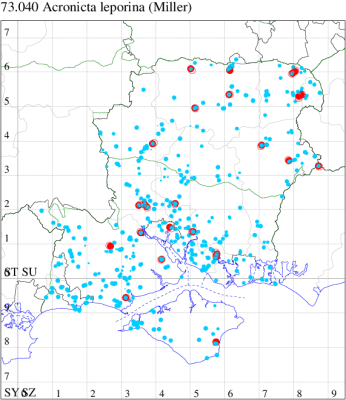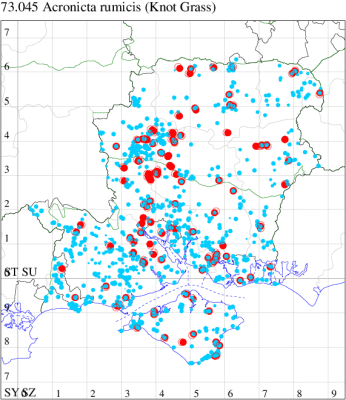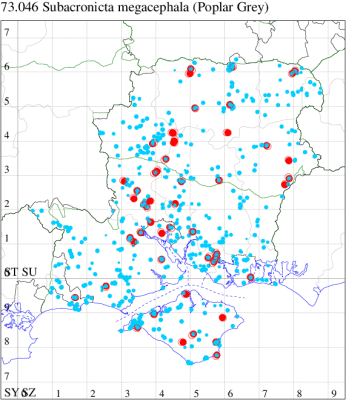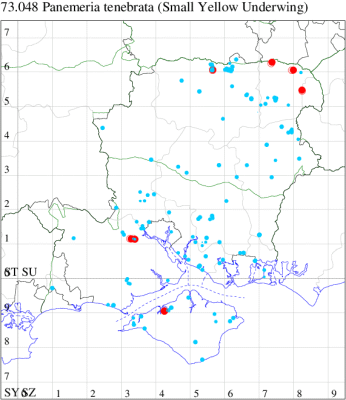2020 Annual Report for: Noctuidae / Acronictinae
For species seen in 2020 that had less than or equal to 100 records, full details are included; for more common species, the earliest, latest and highest count by vice-county are shown. The narrative for each species is taken from the main Hantsmoths website, and it is possible that some information on abundance and occurrence can get out of date, as it is impossible to keep up with all changes; however it should give a good introduction to each species. The tables in each species account summarise the previous status, and that for the current year.
For the maps, all records prior to 2020 are shown by a blue dot (the larger the dot, the more recent), with the current year's records shown in red. As previous records are superimposed on any report for 2020, new sites have greater emphasis (i.e. will show as 'more red').
In the species accounts, an asterisk next to a location indicates a new 10km square record; earliest ever dates are highlighted in orange, and latest ever in red. Initials in the species accounts refer to the recorders listed here. Please get in touch if you identify any omissions or errors, in particular if you have records that have yet to be submitted. Details of how to submit records can be found here.
73.034 [B&F: 2277] Scarce Merveille du Jour Moma alpium (Osbeck, 1778) - Nationally Scarce
A rare Red Data Book species, almost entirely restricted to large areas of well-established oak forest, formerly in southern England from Cornwall to Kent, now only common in the New Forest, west Sussex and the Kentish Weald. In Hampshire and on the Isle of Wight still quite common in New Forest oak woodland, and still present in woods near Wickham and in Havant Thicket, but it has disappeared from other localities where it was fairly common up until the 1950s. Unrecorded on the Isle of Wight since the turn of the 20th Century, until one was reported in 2021. Wingspan 34-40 mm. Unmistakable. Larva feeds on Pedunculate Oak and Sessile Oak, over-wintering as a pupa.
Records prior to 2020
| Vice County | #Records | #Individuals | First Record | Last Record |
|---|---|---|---|---|
| 10 | 8 | 2 | 1800 | 1900 |
| 11 | 470 | 559 | 1800 | 2019 |
2020 records
| Vice County | #Records | #Individuals | Max Quantity |
|---|---|---|---|
| 11 | 1 | 1 | 1 |

Records by year
Records by week (adult)
Records by week (larval)
Record Details
VC11: Romsey, one, 24 Jun (SC); Eastleigh, one, to actinic, 26 Jun (KArb); Sway, one, 01 Jun (SKe)
73.036 [B&F: 2281] Alder Moth Acronicta alni (Linnaeus, 1767) - Local
Local in broad-leaved woodland and scrub throughout much of England and Wales, also in western Ireland. In Hampshire and on the Isle of Wight considered to be a very rare moth until the advent of m.v. light; it is now known to be widespread and fairly common, though only recorded from the north of the Island. Wingspan 35-42 mm. Larva feeds on various broad-leaved trees, including Downy Birch, Alder and Goat Willow, over-wintering as a pupa.
Records prior to 2020
| Vice County | #Records | #Individuals | First Record | Last Record |
|---|---|---|---|---|
| 10 | 48 | 36 | 1981 | 2019 |
| 11 | 422 | 409 | 1951 | 2019 |
| 12 | 195 | 217 | 1951 | 2019 |
2020 records
| Vice County | #Records | #Individuals | Max Quantity |
|---|---|---|---|
| 10 | 4 | 4 | 1 |
| 11 | 4 | 6 | 3 |
| 12 | 1 | 1 | 1 |

Records by year
Records by week (adult)
Records by week (larval)
Record Details
VC10: Shanklin, one, 03 May; one, 20 May; one, 25 May; Shanklin Upper Chine, one, 21 May (IOu);
VC11: Ashurst, NF, one, 21 May (SAB); Romsey, three, 17 May (SLay); one, 13 Jun (MB); Southampton, one, 08 May (MEdg); Lovedean, one, 21 May (ARJ); Milford on Sea, one, 08 May (MMcM);
VC12: Alton, one, to actinic, 25 May (NDP); Yateley*, one, 21 May (JHH)
73.037 [B&F: 2283] Dark Dagger Acronicta tridens ([Denis & Schiffermüller], 1775) - Common
Common in woodland, fens, gardens and a wide range of other habitats throughout much of England and Wales. In Hampshire and on the Isle of Wight very much less common than Grey Dagger, although undoubtedly under-recorded owing to similarity to that species. Wingspan 33-44 mm. Very similar to Grey Dagger A. psi, from which separated only by dissection of the genitalia. The larvae of the two species are readily identifiable. Larva feeds on various broad-leaved trees and shrubs, including Wild Rose, Cultivated Rose, Hawthorn, Blackthorn and Goat Willow, over-wintering as a pupa.
Records prior to 2020
| Vice County | #Records | #Individuals | First Record | Last Record |
|---|---|---|---|---|
| 10 | 21 | 7 | 1900 | 2019 |
| 11 | 195 | 179 | 1951 | 2018 |
| 12 | 71 | 31 | 1951 | 2017 |
2020 records
| Vice County | #Records | #Individuals | Max Quantity |
|---|---|---|---|
| 10 | 1 | 1 | 1 |
| 11 | 2 | 2 | 1 |

Records by year
Records by week (adult)
Records by week (larval)
Record Details
VC10: Shanklin, one, gen det, 25 Jun (IOu);
VC11: Timsbury, one, 08 Jun (TRa); Fareham, one, to actinic, gen det, 12 Jun (MLO det. KJW); Northney, Hayling Island, present, 27 Jun (JWP)
73.038 [B&F: 2284] Grey Dagger Acronicta psi (Linnaeus, 1758) - Common
Common in woodland, hedgerows, gardens, scrubby heathland, calcareous grassland, fens and a wide range of other habitats; low altitudes in the north throughout much of the British Isles, a species of conservation concern under the UK Biodiversity Action Plan. In Hampshire and on the Isle of Wight very much more common than Dark Dagger, but undoubtedly under-recorded. Wingspan 33-44 mm. Very similar to Dark Dagger A. tridens, from which separated only by dissection of the genitalia. The larvae of the two species are readily identifiable. Larva feeds on various broad-leaved trees and shrubs, including Blackthorn, Hawthorn, Apple, Birch, Common Lime, English Elm and Rowan, over-wintering as a pupa.
Records prior to 2020
| Vice County | #Records | #Individuals | First Record | Last Record |
|---|---|---|---|---|
| 10 | 83 | 37 | 1951 | 2018 |
| 11 | 1949 | 2070 | 1949 | 2019 |
| 12 | 319 | 237 | 1949 | 2019 |
2020 records
| Vice County | #Records | #Individuals | Max Quantity |
|---|---|---|---|
| 10 | 3 | 3 | 1 |
| 11 | 12 | 13 | 3 |
| 12 | 6 | 6 | 1 |

Records by year
Records by week (adult)
Records by week (larval)
Record Details
VC10: Parkhurst Forest, larva, one, field observation, feeding on Beech, 05 Sep; Shanklin, one, gen det, 08 Jun (IOu); Wootton, larva, one, field observation, 15 Jul (KShw);
VC11: Hollands Wood, NF, larva, one, field observation, beaten from oak, 28 Sep (DAS); Woodlands, New Forest, present, 09 May (RBW); Ashurst, NF, one, 08 Aug; one, 10 Aug; three, 12 Aug (SAB); Wildern LNR, larva, one, field observation, 22 Sep (TCr); Clausentum Fen, NF, larva, one, field observation, 10 Oct (ABal); Fareham, larva, one, field observation, 14 Sep (ADT); larva, one, field observation, on pear tree leaf, 12 Sep (PBrf); one, to actinic, gen det, 01 Sep (MLO det. KJW); Portsmouth, one, 04 Aug (IRT); West Walk, one, ♂, 14 Aug (F.M.G.); Havant, larva, one, field observation, 27 Sep (iNat); Northney, Hayling Island, present, 26 Jun; present, 09 Jul; present, 13 Jul; present, 22 Aug (JWP); Southsea, one, 09 May (JRL);
VC12: Kings Worthy, larva, one, field observation, 27 Aug (iNat); Overton, larva, one, field observation, 12 Sep; larva, one, field observation, 27 Sep (DClu); Liss, one, 25 Jun; one, 14 Aug (LBe); Hammer Vale, Woolmer, one, 04 May; one, 15 Aug (ASw); Yateley, larva, two, field observation, on apple, 13 Sep; one, ♂, gen det, 23 Jun (JHH det. JHH)
73.039 [B&F: 2279] Sycamore Acronicta aceris (Linnaeus, 1758) - Local
Local in parks, gardens, woodland and scrub throughout southern England. In Hampshire and on the Isle of Wight widespread and fairly common, particularly in suburban area. Wingspan 41-49 mm. The main confusion species are Poplar Grey A. megacephala and Sweet Gale Moth A. euphorbiae, but has characteristic S-shaped subterminal band of pale grey blocks. Larva feeds on Horse-chestnut, Sycamore and Field Maple, over-wintering as a pupa.
Records prior to 2020
| Vice County | #Records | #Individuals | First Record | Last Record |
|---|---|---|---|---|
| 10 | 177 | 186 | 1951 | 2019 |
| 11 | 1473 | 1484 | 1951 | 2019 |
| 12 | 569 | 593 | 1951 | 2019 |
2020 records
| Vice County | #Records | #Individuals | Max Quantity |
|---|---|---|---|
| 10 | 4 | 7 | 3 |
| 11 | 24 | 25 | 2 |
| 12 | 10 | 11 | 2 |

Records by year
Records by week (adult)
Records by week (larval)
Record Details
VC10: Freshwater Cliffs, two, 16 Jul (SDa); Shanklin, one, 28 May; three, 25 Jun; one, 20 Jul (IOu);
VC11: Marchwood, one, 24 Jun (CTh); Woodlands, New Forest, present, 19 May (RBW); Totton, one, 22 May; two, 11 Jul (LH); Romsey, one, 24 Jun (SLay); one, 11 Jul (NRJ); Dibden Purlieu, one, to actinic, 13 Aug; one, to actinic, 25 Jun (RAC); Bitterne, one, to actinic, 21 May (PAB); Eastleigh, one, to actinic, 26 Jun; one, to actinic, 27 Jun (KArb); Winchester, one, 04 Jul (THW); Catisfield, one, to actinic, 25 Jun (ALR); Fareham, one, 16 Jul (ADT); one, 01 Jul; two, 15 Jul (KJW); Botley, one, to actinic, 23 Jun; one, to actinic, 25 Jun; one, to actinic, 05 Jul; one, to actinic, 25 Jun; one, to actinic, 04 Jul (SLB); Wickham Common, one, 12 Aug (KC); Burton, nr Christchurch, one, 10 Jul (JSw); Milford on Sea, one, 25 Jun (MMcM); Southsea, larva, one, field observation, 02 Aug (HJo);
VC12: Basingstoke, one, 22 Jun; one, 26 Jun (MJW); Alton, one, to actinic, 30 May; one, to actinic, 07 Jul (BCA); one, to actinic, 23 Jun (NDP); Whitehill, one, to actinic, 17 Jun; two, to actinic, 25 Jun; one, to actinic, 24 Jul (ASto); Farnham*, larva, one, field observation, 24 Aug (iNat); Farnborough, one, 09 May; one, 08 Aug (KBW)
73.040 [B&F: 2280] Miller Acronicta leporina (Linnaeus, 1758) - Common
Common in broad-leaved woodland, heathland, moorland, fens and gardens throughout the British Isles. Widespread and fairly common in Hampshire and on the Isle of Wight. Wingspan 37-48 mm. Apart from the occasional melanic individual, generally unmistakable. Larva feeds on Downy and Silver Birch, Alder and Grey Willow, over-wintering as a pupa.
Records prior to 2020
| Vice County | #Records | #Individuals | First Record | Last Record |
|---|---|---|---|---|
| 10 | 92 | 97 | 1951 | 2019 |
| 11 | 1626 | 1661 | 1949 | 2019 |
| 12 | 531 | 604 | 1951 | 2019 |
2020 records
| Vice County | #Records | #Individuals | Max Quantity |
|---|---|---|---|
| 10 | 1 | 1 | 1 |
| 11 | 24 | 28 | 3 |
| 12 | 12 | 13 | 2 |

Records by year
Records by week (adult)
Records by week (larval)
Record Details
VC10: Shanklin, one, 24 Jun (IOu);
VC11: Acres Down, one, 08 Aug (CWlk); Totton, one, 07 Aug; one, 08 Aug; one, 09 Aug; one, 10 Aug (LH); Romsey, one, 25 Jun (SC); one, 02 Jun; three, 24 Jun (SLay); one, 18 Jul (MB); Dibden Purlieu, one, to actinic, 25 Jun; one, to actinic, 12 Aug (RAC); Southampton, one, to actinic, 16 Jun; one, 10 Jul (MEdg); one, to actinic, 17 May; one, to actinic, 21 Jun (MGP); Eastleigh, one, to actinic, 09 Aug (KArb); Allbrook, one, 24 Jun; one, to actinic, 25 Jun (SI); Fareham, one, to actinic, 05 Aug (MLO); one, 27 Apr (KJW); Botley, two, to actinic, 25 Jun; two, to actinic, 26 Jun; one, to actinic, 27 Jun; one, to actinic, 11 Aug (SLB); Northney, Hayling Island, present, 22 Jun; present, 31 Jul (JWP); Sway, one, 23 Jun (SKe); Pennington, one, 13 Aug (RFC);
VC12: Chilbolton, one, to actinic, 09 Aug (SLE det. GCE); Harestock, one, 20 Jun; one, to actinic, 21 Jun (GRog); Overton, one, 25 Jun; one, 26 Jun (MSi); Ecchinswell, one, 08 Aug (MJN); Basingstoke, one, 24 Jun; two, 26 Jun (MJW); Pamber Forest, one, 30 May (GJD); Alton, one, to actinic, 15 Jun (BCA); Whitehill, one, to actinic, 29 May (ASto); Castle Bottom NNR, present, 25 Jun (JHH, AMD); Hammer Vale, Woolmer, one, 30 May (ASw); Fleet, one, 24 Jun (MHals); Velmead Wood, Fleet, larva, one, field observation, 18 Jul (JChe); Yateley, one, 31 Jul (JHH)
73.041 [B&F: 2285] Marsh Dagger Acronicta strigosa ([Denis & Schiffermüller], 1775) - Extinct
Formerly an uncommon resident in the fens of Cambridgeshire and Huntingdonshire, last seen in 1930’s. Since which it has appeared in southern England rarely as an immigrant from the continent, in East Sussex in 1996, and at Pagham Harbour, West Sussex, in July 2010, to which can be added one of the more surprising records of recent years, when an individual turned up in JHa’s Bonchurch (VC10) trap on 2 Aug 2015, and which is therefore a first for the Isle of Wight and for our area. Perhaps even more remarkably, the same recorder pulled in a second, on almost the same date in 2020. Wingspan 30-32 mm. Shows a strong black streak medially from base to claviform stigma, and two others in echelon above tornus (MBGBI Vol 10). Larva feeds on Hawthorn and Blackthorn.
Records prior to 2020
| Vice County | #Records | #Individuals | First Record | Last Record |
|---|---|---|---|---|
| 10 | 1 | 1 | 2015 | 2015 |
2020 records
| Vice County | #Records | #Individuals | Max Quantity |
|---|---|---|---|
| 10 | 1 | 1 | 1 |

Records by year
Records by week (adult)
Records by week (larval)
Record Details
VC10: Bonchurch, one, 07 Aug (JHa)
73.045 [B&F: 2289] Knot Grass Acronicta rumicis (Linnaeus, 1758) - Common
Common on grassland, heathland, marshes, gardens and a wide range of other habitats throughout much of the British Isles. In Hampshire and on the Isle of Wight widespread and common in all three vice-counties. Wingspan 35-43 mm. Superficially similar to other Acronicta species, it can usually be distinguished by the curved white mark near the rear edge of the forewing, which is normally present even in melanic specimens. Larva feeds on various herbaceous and woody plants, including Broad-leaved Dock, Common Sorrel, Ribwort Plantain, Greater Plantain, Water Mint, Bramble, Hop, Hawthorn and Burnet Rose, over-wintering as a pupa.
Records prior to 2020
| Vice County | #Records | #Individuals | First Record | Last Record |
|---|---|---|---|---|
| 10 | 460 | 663 | 1951 | 2019 |
| 11 | 6001 | 7497 | 1951 | 2019 |
| 12 | 1259 | 1524 | 1951 | 2019 |
2020 records
| Vice County | #Records | #Individuals | Max Quantity |
|---|---|---|---|
| 10 | 47 | 56 | 3 |
| 11 | 262 | 344 | 7 |
| 12 | 86 | 116 | 6 |

Records by year
Records by week (adult)
Records by week (larval)
Record Summary
VC10: Earliest: Bonchurch, 06 Apr, 1 (JHa) Latest: Shanklin, 26 Aug, 1 (IOu) Max count: Shanklin Upper Chine, 31 Jul, 3 (IOu)
VC11: Earliest: Southampton, 08 Apr, 1 (MGP) Latest: Nursling Substation, 09 Oct, 1 (JClx) Max count: Portsmouth, 24 Jul, 7 (IRT)
VC12: Earliest: Ecchinswell, 22 Apr, 1 (MJN) Latest: Stroud, Petersfield, 27 Sep, 1 (RAll) Max count: Beech, 23 Jul, 6 (NDP)
73.046 [B&F: 2278] Poplar Grey Subacronicta megacephala ([Denis & Schiffermüller], 1775) - Common
Common in woodland, fens, parks and gardens throughout the British Isles. Widespread and common in Hampshire and on the Isle of Wight. Wingspan 38-45 mm. Could be confused with Sycamore A. aceris. Larva feeds on Black and White Poplar, and Aspen, over-wintering as a pupa.
Records prior to 2020
| Vice County | #Records | #Individuals | First Record | Last Record |
|---|---|---|---|---|
| 10 | 278 | 425 | 1951 | 2019 |
| 11 | 1988 | 2278 | 1951 | 2019 |
| 12 | 829 | 956 | 1948 | 2019 |
2020 records
| Vice County | #Records | #Individuals | Max Quantity |
|---|---|---|---|
| 10 | 14 | 19 | 3 |
| 11 | 67 | 83 | 11 |
| 12 | 33 | 36 | 3 |

Records by year
Records by week (adult)
Records by week (larval)
Record Summary
VC10: Earliest: Cowes, 08 May, 1 (DNor) Latest: Kingston, 16 Jul, 3 (ENes) Max count: Kingston, 16 Jul, 3 (ENes)
VC11: Earliest: Botley, 09 Apr, 1 (SLB) Latest: Botley, 16 Aug, 1 (SLB) Max count: Fareham, 06 Aug, 11 (MLO)
VC12: Earliest: Ecchinswell, 22 Apr, 1 (MJN) Latest: Pamber Forest, 10 Aug, 1 (GJD) Max count: Liss Forest, 27 Jun, 3 (RJM)
73.047 [B&F: 2291] Coronet Craniophora ligustri ([Denis & Schiffermüller], 1775) - Local
Local in a wide variety of habitats, including hedgerows, woodland, calcareous grassland, fens and hillsides throughout the British Isles. In Hampshire widespread and locally frequent in the south, less common in the north and on the Isle of Wight. Wingspan 35-42 mm. Only likely to be confused with dark forms of Poplar Grey Acronicta megacephala, but smaller, with more rounded apex. Larva feeds predominantly on Ash, but also on Alder and Hazel, over-wintering as a pupa.
Records prior to 2020
| Vice County | #Records | #Individuals | First Record | Last Record |
|---|---|---|---|---|
| 10 | 757 | 3156 | 1951 | 2019 |
| 11 | 4551 | 8642 | 1881 | 2019 |
| 12 | 1846 | 5417 | 1949 | 2019 |
2020 records
| Vice County | #Records | #Individuals | Max Quantity |
|---|---|---|---|
| 10 | 55 | 223 | 22 |
| 11 | 186 | 276 | 10 |
| 12 | 76 | 111 | 6 |

Records by year
Records by week (adult)
Records by week (larval)
Record Summary
VC10: Earliest: Bonchurch, 25 May, 1 (JHa) Latest: Shanklin, 20 Sep, 1 (IOu) Max count: West High Down Quarry, 07 Aug, 22 (IOu)
VC11: Earliest: Southampton, 17 May, 1 (MGP) Latest: Botley, 17 Aug, 1 (SLB) Max count: Winchester, 07 Jul, 10 (THW)
VC12: Earliest: Pamber Forest, 18 May, 1 (GJD) Latest: Liss Forest, 15 Aug, 1 (RJM) Max count: Cholderton, 17 Jul, 20 (TJN, HE)
73.048 [B&F: 2397] Small Yellow Underwing Panemeria tenebrata (Scopoli, 1763) - Local
Local in flower meadows, calcareous grassland, roadside verges and sea cliffs throughout England and Wales. In Hampshire and on the Isle of Wight scattered colonies of this species occur on meadows and downs, but rare in the New Forest. Wingspan 18-20 mm. Flies during the day in sunshine. Hindwing primrose-yellow with broad black border to one-third and heavy black suffusion at base (MBGBI Vol 10), together with day-flying habit and small size preclude confusion with any other British moth, although it has been compared to the pyralid Pyrausta aurata. Larva feeds on seed capsules of Common Mouse-ear and Field Mouse-ear, over-wintering as a pupa.
Records prior to 2020
| Vice County | #Records | #Individuals | First Record | Last Record |
|---|---|---|---|---|
| 10 | 42 | 29 | 1856 | 2018 |
| 11 | 117 | 88 | 1951 | 2017 |
| 12 | 126 | 140 | 1951 | 2017 |
2020 records
| Vice County | #Records | #Individuals | Max Quantity |
|---|---|---|---|
| 10 | 1 | 2 | 2 |
| 11 | 2 | 0 | 0 |
| 12 | 2 | 2 | 1 |

Records by year
Records by week (adult)
Records by week (larval)
Record Details
VC10: Newtown Meadows, two, 17 May (IOu);
VC11: Woodlands, New Forest, present, field observation, 20 Apr; Fletchwood Meadows, NF, present, field observation, 14 May (RBW);
VC12: Andover*, present, field observation, 31 Jul (TSte); Axmansford, one, field observation, 17 May (ACB); Yateley*, one, netted, 16 May; one, field observation, 26 Apr (JHH); Fleet Pond, one, field observation, 25 May (MHals)